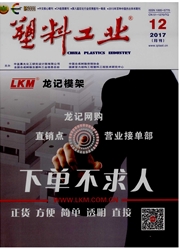

 中文摘要:
中文摘要:
采用布拉本德实验仪模拟微注射成型过程,研究结晶型聚合物微注射成型过程的剪切诱导结晶。结果表明,其他工艺参数不变时,当班伯里转子转速从40r/min增加到80r/min,试样的结晶度从74.43%增大到84.36%,结晶度随着剪切速率的增加而增大,剪切速率促进剪切诱导结晶的形成;当熔体初始温度从145℃升至185℃时,试样结晶度从74.96%增大到79.43%,结晶度随着熔体初始温度的上升而增大;当剪切时间从10min增加到20min时,试样结晶度从77.48%增大到80.17%,结晶度随着剪切时间的增加而增大,剪切作用可以促进结晶。比较动态与静态DSC的实验结果,动态结晶度(79.43%)高于静态结晶度(77.48%)。在同样的热历史影响下,剪切等外力场作用会促进HDPE的结晶过程。将上述结晶过程的研究结果应用于微注射成型生产实际,可从结晶度的角度来优化微注射成型熔体温度、注射压力和注射速率等工艺参数,提高成型零件的质量。
 英文摘要:
英文摘要:
Brabender plasti-eorder lab-station was made to simulate the process of micro-injection molding, and the shear induced crystallization of crystalline polymers was investigated in micro-injection molding. When other processing parameters were given, the erystallinity was enhanced from 74.43% to 84.36% as the rotational speed of Banbury blades increased from 40 r/min to 80 r/min, which enhanced with the increase of shear rate that promoted the shear induced crystallization. The erystallinity was enhanced from 74.96% to 79.43% as the melt temperature elevated from 145 ℃ to 185 ℃, which enhanced with the elevation of melt temperature. The erystallinity was enhanced from 77.48% to 80.17% as the shear time increased from 10 min to 20 min, which enhanced with the increase of shear time. Compared with the static DSC experiment results, the dynamic erystallinity was higher than that of statie's (79.43 % vs. 77.48 % ). Given the same heat history, the action of outer forces like shear stresses would make HDPE melts quicken its crystallization process. Applying the forementioned study results of crystallization process to production of micro-injection molding, the processing parameters, such as melt temperature, injection pressure and injection velocity could be optimized to improve the quality of the molded part from the erystallinity point of view.
 同期刊论文项目
同期刊论文项目
 同项目期刊论文
同项目期刊论文
 期刊信息
期刊信息
